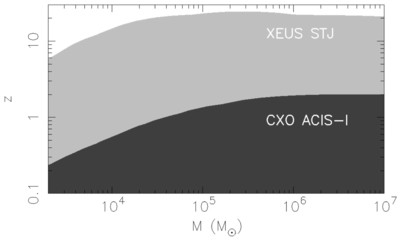Image Details

Caption: Fig. 2.
Redshifts at which emission from an Eddington‐accreting (﹩\dot{m}=1﹩) black hole of mass M can be detected with 105 s exposure using the instrument ACIS‐I on Chandra (dark gray) and the Hafnium superconducting tunneling junction (STJ) detector on XEUS before mission upgrade (light gray). We assume that 10 counts constitute detection and ignore absorption and confusion. The disk spectra were thermal modified blackbody spectra for a nearly maximally spinning black hole, ﹩a_{*}=0.9﹩. We assume the standard ΛCDM cosmology with ﹩H_{0}=70﹩ km s−1 Mpc−1, ﹩\Omega _{m}=0.3﹩, and ﹩\Omega _{\Lambda }=0.7﹩.
Copyright and Terms & Conditions
© 2005. The American Astronomical Society. All rights reserved. Printed in U.S.A.




